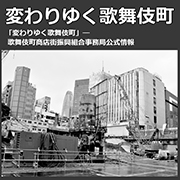Take a stroll and view kabukicho

 5-17-3 Shinjuku
5-17-3 ShinjukuTEL:03-3209-5265
The birth of Naitoh Shinjuku
Shinjuku used to be called "NaitohShinjuku" or "Oiwake Shinjuku", which means "the new accommodation area built in front of the property of Naitoh mansion".
The time when Naitoh bestowed Shinjuku, the area was quiet, and despite being right on the main street,had no hotels. At the time, the area with hotels was Takaido, about 10 miles away from Shinjuku.
This was inconvenient for people, so Kihei Takamatsu (headman of Abekawa town, Asakusa) applied to establish hotels on Naitoh family's property in exchange for government payments in 1698.
That is why it used to be called "Naitoh Shinjuku".
Hanazono shrine, the land of blooming culture.
Back in the day Hanazono shrine was supposed to be a big village shrine, and many people would visit for the sake of their religious faith.
When it needed a restoration due to the big fires in 1780 and 1811, they added a stage for plays and dance shows. This was the beginning of the performing arts culture of Hanazono shrine.
After World War II, the town where Koshu Kaido and Oume Kaido cross became a place of energetic spirits.
In Japan, the origin of the entertainment business is said to have come from the shrines. Hanazono shrine is not an exception.
 1-13-3 Kabukicho
1-13-3 KabukichoTEL:03-3209-9291
The fortune of Benzaiten, and the origin of Kabuki Benzaiten.
The god of music, dancing, and thriving business.
The fortune of Benzaiten, and the origin of Kabuki Benzaiten.
Kabukicho used to be swampland where lots of gods were enshrined.
In April of 1945, the shrine with all of its amulets was burnt down. One devoted believer evacuated Benzaiten from the tragedy.
Kihei Suzuki, leader of restoration association, had built a temporary shrine for Benzaiten before they restored the town itself in 1946.
This is where the shrine still stands. On the monument in the shrine, the following is inscribed "In honour of our everlasting respect for Benzaiten as a neighbourhood guardian".

 2-11-2 Nishi-Shinjuku
2-11-2 Nishi-ShinjukuTEL:03-3343-5521
In the centre of Tokyo, a culturally traditional shrine surrounded by trees
The origin of the Junisha Kumano Shrine is as follows: A wealthy Nakano district citizen, Kuro Suzuki, moved Junisho Gongen (gods) from Kumano Sanzan (his birthplace) to Tokyo from 1394-1428.
Kuro deified a god of Kumano while he was working on the cultivation of this area.
After the Suzuki family became wealthy, Kuro brought all the Junisha Gongen from Kumano Sanzan in 1403.
In the Edo era, Shinjuku Junisha Kumano Shrine became a famous place for its beautiful scenery, including a waterfall and a pond. Artists of the day would often spend time in the area.
 2-17-5 Kabukicho
2-17-5 Kabukicho03-3200-2904
Standing in Kabukicho 2-chome, Kio Shrine, the only shrine at which the demon occasionally becomes benevolent, was constructed to enshrine both the Inari god of Okubo village, and Kiou Gongen. Inside the shrine, there are wooden zodiac animal statues, which are said to give you luck if touched.
The god Ebisu, one of the 7 Shinjuku Yamanote gods is enshrined in Mishima Shrine, which lies inside Inari Kio Shrine.






























